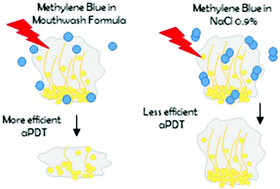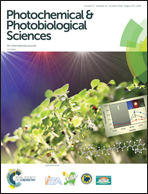Controlling methylene blue aggregation: a more efficient alternative to treat Candida albicans infections using photodynamic therapy
Abstract
Methylene Blue (MB) has been widely used in antimicrobial Photodynamic Therapy (aPDT), however, the mechanisms of action (Type I or Type II) are defined by its state of aggregation. In this sense, the identification of the relationships between aggregation, the mechanisms of action and the effectiveness against microorganisms, as well as the establishment of the means and the formulations that may favor the most effective mechanisms, are essential. Thus, the objective of this study was to assess the in vitro aPDT efficacies against Candida albicans, by using MB in vehicles which may influence the aggregation and present an oral formulation (OF) containing MB, to be used in clinical aPDT procedures. The efficacy of MB at 20 mg L−1 was tested in a range of vehicles (water, physiological solution – NaCl 0.9%, phosphate saline buffer – PBS, sodium dodecyl sulfate 0.25% – SDS and urea 1 mol L−1) in a C. albicans planktonic culture, when using 4.68 J cm−2 of 640 ± 12 nm LED for the irradiations, as well as 5 minutes of pre-irradiation time, together with measuring the UFC mL−1. Based upon these analyses, an OF containing MB in the most effective vehicle was tested in the biofilms, as a proposal for clinical applications. When comparing some of the vehicles, sodium dodecyl sulfate was the only one that enhanced an MB aPDT efficacy in a planktonic C. albicans culture. This OF was tested in the biofilms and 50 mg L−1 MB was necessary, in order to achieve some reduction in the cell viabilities after the various treatments. The light dosimetries still need further adaptations, in order for this formulation to be used in clinical applications. The present research has indicated that the development of this formulation for the control of MB aggregations may result in more effective clinical protocols.



 Please wait while we load your content...
Please wait while we load your content...